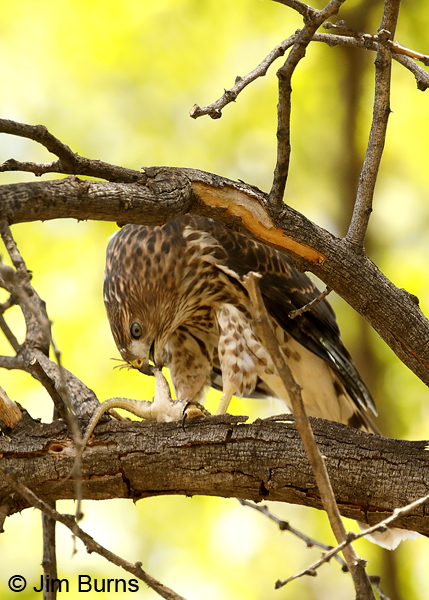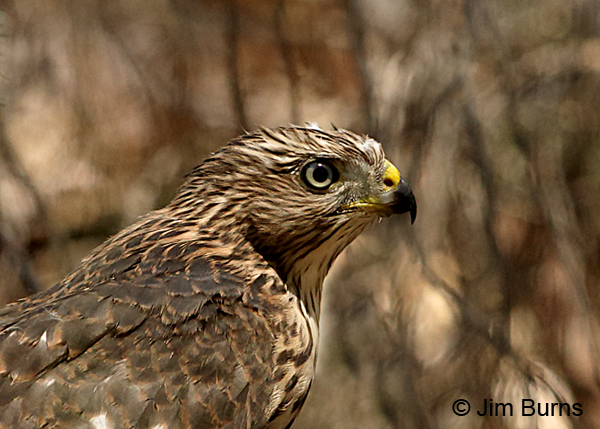
My lovely wife, however, had hit the Coop jackpot on her very first organized field trip. In a park in Seattle, with new binoculars and in a group that included veteran birders and an experienced leader, her initial foray into her birding life recorded a Cooper’s Hawk snatching a starling out of the air a few feet above the ground! That was in the winter of 1975. I had been busy and had not accompanied her that day.
It would be three years before I could, in good conscience, say that I had seen a Cooper’s Hawk. On a field trip along Sycamore Creek south of the Mazatzal Mountains in central Arizona, our expert and long since deceased leader, Bob Bradley, identified a Cooper’s Hawk that had teed up in a dead snag thirty yards away. I was elated to record this verified life sighting.
As seems often the case with long sought lifers, things became easier after that, but of course I was probably deluding myself about my ability to distinguish between the three North American accipiters. My birding log now indicates I’ve seen Coops in eleven states and two Canadian provinces, and I’ve seen what I believed to be Cooper’s plucking three different species of bird prey, but I have yet to record an actual prey capture as Deva did on her first time out in her birding life that has waxed and waned over the past half century.
Coops are bird specialists. A Cooper’s Hawk encounter is typically a fleeting glance at an efficient and beautiful predator exquisitely evolved to capture birds on the wing within the tight confines of woods and forests. Like their prey species, however, they have evolved to survive, and they ply their raptorial trade now in close proximity to urban areas with birders and more open spaces. This fact led, in a convoluted way, to my so-called career as a bird photographer.
One morning in the early ‘80s on my daily run along a canal bank I was surprised to see a hawk fly into a Sycamore tree fifty yards ahead, even more surprised when it did not flush as I ran under it, falling down trying to look up, and saw it was probably a Cooper’s Hawk. Hours later, guide book in hand, I realized this encounter had been with a juvenile, and years later I would come to know juveniles to be much more approachable, “confiding” in birding’s lexicon, than adults.
Being a very visual person, always fascinated by the splotchy, dappled appearance of Sycamore bark, and ecstatic over this close encounter, I decided on a whim and with zero training or prior experience to paint the picture that was stuck in my head of the Cooper’s Hawk in the Sycamore tree. Of course it soon became apparent I was also on zero with artistic aptitude or talent, and I decided taking a picture rather than painting one might be a more feasible and rewarding way to capture the unique moments in my birding life. That’s when I began to consider pointing my camera’s lens at birds in addition to wildflowers and landscapes. It also marked the beginning of many frustrating years, two decades really, of trying to capture good images of our most frequently seen (in Arizona at least) accipiter species, and coming to realize Cooper’s Hawks are one of the more difficult North American raptors to find, see diagnostically well, and record with the camera.
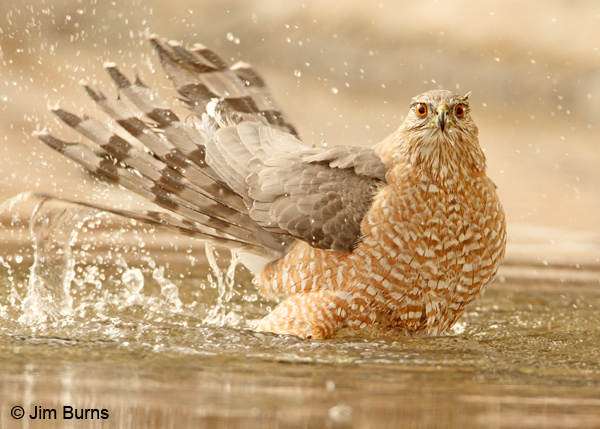
* * *
I began hearing the sound as I again neared the vicinity of the shed, a low, incessant chittering, so soft I had to stop walking to be sure I was actually hearing something and to attempt to locate the source. Following only my ears because I still had no visuals nor any idea what bird might be making the calls, several times I had to turn this way and that to reorient my steps toward the sounds. The calls seemed to be ventriloquial, at first emanating from ground level. Peripheral movement from above, however, caught my eye, and I looked up to see two juvenile Cooper’s Hawk close together in a tall tree, a Eucalyptus, behind the shed.
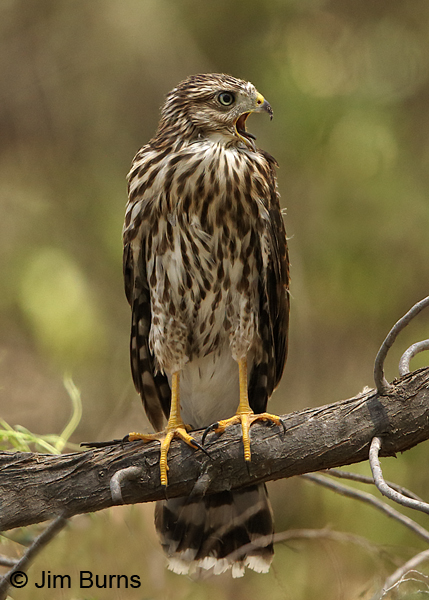
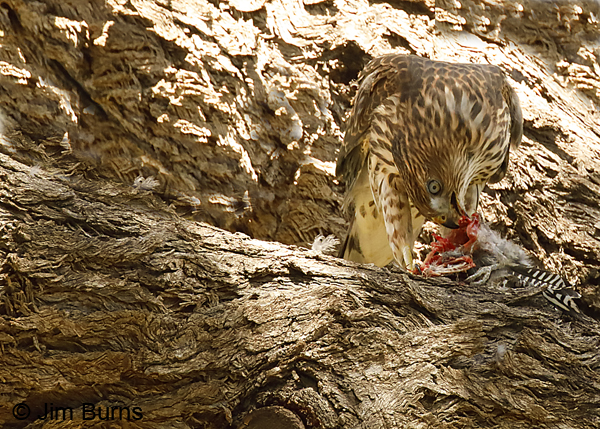
My lasting impression of the drama playing out in the Eucalyptus was how long it took for the Coop to consume its meal. These fledglings were several days, perhaps over a week, out of the nest and already fully as big as the parents. From my vantage point it appeared the Coop was three times the size of the prey, yet breakfast lasted at least half an hour. The ideal branch, or table if you will, for a feeding raptor apparently needs to be both thick and wide enough for it to securely pin the carcass down while dismantling it.
This young Cooper’s had chosen a good table, but seemed inexperienced at the plucking and dismantling part. Several times as it worked, the bird lost its balance, lifting one or the other foot to reposition, and then appeared flummoxed when the carcass, stuck on the talons of one of the feet, would end up in the air, elevated over the table, making it impossible to pluck. The hungry sibling finally left, still whining, and shortly thereafter I noticed an adult bird, probably the parent male judging by its small size, take off from above the grove of trees, circle higher and higher, catch a mid-morning thermal, and disappear downwind. I assume at this stage of raising young a parent’s work is never done.
Eventually the juvenile finished with the woodpecker carcass and dropped into the grove out of sight. I walked down the path and found a shady spot to peruse my images, process my admiration for these young birds already adept at their predatory craft, and decide whether to wait for more action or head for home. The soft whining calls of the juveniles again filled the air, though there were no birds that I could see and my feeble brain, overloaded with camera settings and light angles from shooting the woodpecker feast, had still not stumbled onto the third insight of the morning, the one that should have been most obvious.
I was just off the path, my back against another large tree, part of the perimeter of a small circular clearing, perhaps ten yards across, behind me, and shielded from my view by the girth of the tree trunk. Hearing a commotion in the clearing behind me, I took two slow, soft steps around the trunk. Unbelievably I found myself face to face with Mrs. Cooper, ten yards away on the lowest branch of a brush pile! No way of knowing which of us was more surprised, but we both froze, staring, me because I knew I’d never be this close to a live, wild, adult Cooper’s Hawk again in my lifetime, she because . . . why!? The answer dropped suddenly into our midst.
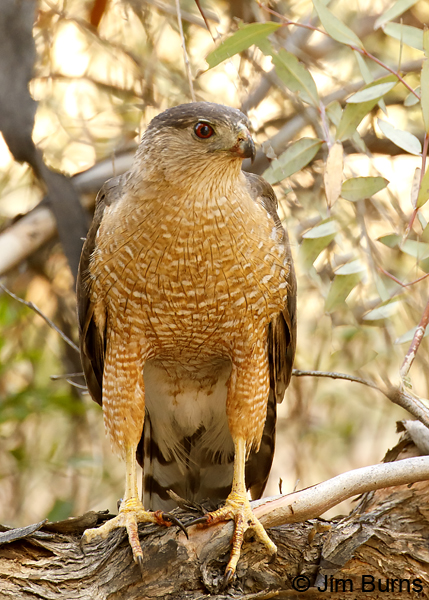
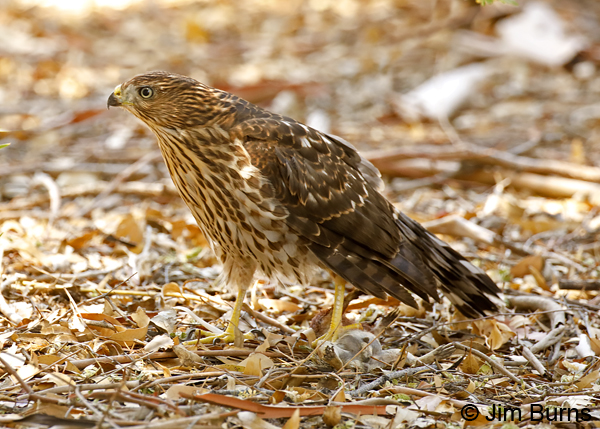
I gasped out loud with astonishment. As the young Cooper’s landed above me I saw, dangling now from his talons, what the mother had dropped off for him. In the momentary chaos of the fraught encounter in the crowded clearing I hadn’t the time, the thought, or the visual acuity to see the prey item lying amongst the brown, dappled leaves between us, but the young bird had seen it and instantly stooped on it. It was carrying a Golden-mantled Ground Squirrel. Headless.
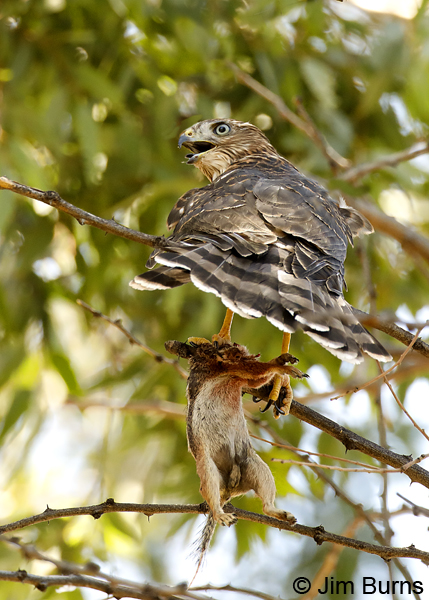
I sat down under the Sycamore to collect my thoughts, scrolling through the images on the back of the camera, coming back again and again to two—Mrs. Cooper, the assassin with blood on her beak and talons, and the second juvenile with prey, an image at once exquisite and excruciating, defiance on its face, the decapitated squirrel dangling from its talons only a piece of meat, a stark reminder that nature is a marketplace.
Just as I thought the show probably over in the mid-day heat, I saw the female flash through an opening across a dry creek bed, the incessant begging stopped for a moment, and a different juvenile dropped to the ground, picked something up and carried it first to the roof of the shed and then on into another tree farther from the nest. Following discreetly but with no concern for the sun angle now at straight-up noon, I discovered the latest item on the Coop kids menu to be a Desert Iguana. So, juvenile accipiters as large as their parents are not quite ready to hunt on their own, still beg incessantly, do not share with one another, and have an eclectic diet. I had just completed an advanced course on the breeding ecology of Cooper’s Hawks, the camera my notebook.